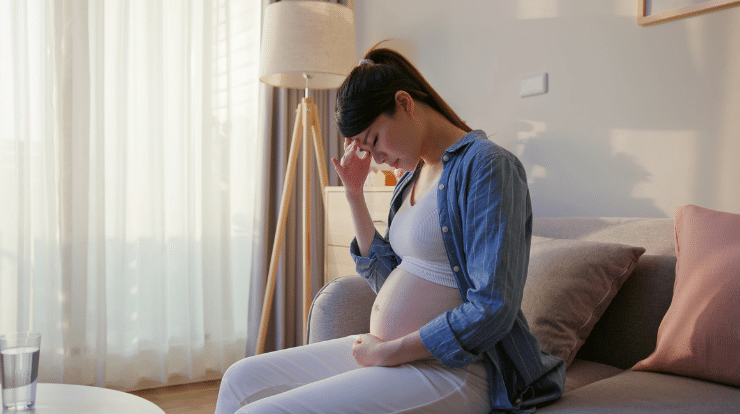
High risk pregnancy is one that involves complications that could put the mother or baby at risk. There are a number of different factors that can contribute to high risk pregnancy. Many high risk pregnancies can be successfully managed with lifestyle changes and close monitoring by a healthcare team. However, in some cases, more aggressive treatment may be necessary to ensure the health of both mother and child. Regardless of the individual circumstances, all high risk pregnancies should be closely monitored by a qualified healthcare provider.
List of high risk pregnancy conditions:
A high-risk pregnancy is one that threatens the health or life of the mother or her baby. Many factors can contribute including:
- Obesity
- High blood pressure.
- Diabetes.
- A history of previous miscarriages.
- Women who are over the age of 35.
- Women who are under the age of 17.
- Women who have a family history of genetic disorders are also at an increased risk.
- Women who are pregnant with multiple babies (Twins)
In some cases, complications develop during pregnancy that put the mother and baby at risk. These can include:
- Placenta previa
- Preeclampsia
While every pregnancy has some element of risk, high-risk pregnancies require close monitoring by a team of healthcare professionals to ensure the best possible outcome for mother and child.
What age is considered a high risk pregnancy?
Pregnancy is a beautiful but also a high risk time for many women. One of the things that can increase the risk for problems during pregnancy is the age of the mother-to-be. For example, women under the age of 17 or over the age of 35 are considered to be at a higher risk for complications during pregnancy. This is because:
- The younger the mother is (under the age of 17), the less developed her reproductive system is.
- Older mothers (over the age of 35) are more likely to have chronic health conditions that can complicate pregnancy.
That being said, every woman’s body is different and there are many healthy pregnancies in women of all ages. The best way to ensure a healthy pregnancy is to consult with a doctor and receive regular prenatal care.
How to prevent high risk pregnancy?
Here are 7 Tips to prevent high risk pregnancy:
1. Getting regular exercise
Getting regular exercise is one of the best things you can do for your health, and it’s especially important if you’re pregnant. Exercise can help to prevent a number of pregnancy complications, including pre-eclampsia, gestational diabetes, and deep vein thrombosis. It can also help to reduce the risk of delivering a baby who is large for gestational age.
Getting at least 30 minutes of moderate exercise most days of the week is recommended for pregnant women. If you have any medical conditions or concerns, be sure to talk to your doctor before starting an exercise program. Getting regular exercise during pregnancy is an important way to keep both you and your baby healthy.

2. Eating a healthy diet
Eating a healthy diet is essential for any woman who is pregnant or planning to become pregnant. A nutritious diet helps to ensure a healthy pregnancy and a healthy baby. However, women who are at high risk for complications during pregnancy need to be especially careful about their diet.
Eating a balanced diet with plenty of fruits, vegetables, and whole grains can help to reduce the risk of preeclampsia, gestational diabetes, and other pregnancy complications. Women who are at high risk for complications should talk to their doctor about the best way to eat for a healthy pregnancy. By following a healthy diet, women can help to reduce their risk of complications and ensure a healthy pregnancy.
3. Avoiding tobacco and alcohol use
Avoiding tobacco and alcohol use during pregnancy is vital to preventing high-risk pregnancies. Both tobacco and alcohol use can lead to a variety of health problems for both the mother and the developing baby.
Smoking cigarettes during pregnancy increases the risk of miscarriage, preterm labor, low birth weight, and Sudden Infant Death Syndrome (SIDS). Alcohol consumption during pregnancy can also lead to a host of problems, including fetal alcohol syndrome, preterm labor, and low birth weight.
4. Getting adequate rest
Getting adequate rest is an important part of pregnancy, especially in the later stages. It can help to prevent complications such as pre-eclampsia, which can be dangerous for both mother and baby. Getting enough rest can be difficult, especially if you have other children to care for or a demanding job. However, there are some things you can do to make it easier. For example, you can try to take a nap during the day if possible, and go to bed early at night. You can also ask your partner or family members for help with household chores and child care.
5. Managing stress levels
Managing stress levels to prevent high risk pregnancy is important for the health of both the mother and the child. When a woman is pregnant, her body goes through a lot of changes. Hormones are released that can cause mood swings and emotional ups and downs. At the same time, the body is also working hard to support the developing fetus. This can lead to a lot of physical and emotional stress. Managing stress levels can help to reduce the risk of complications during pregnancy.
6. Taking prenatal vitamins
Taking prenatal vitamins is one of the best things you can do for your body during pregnancy. They help to ensure that you and your baby are getting the nutrients you need, and they can also help to prevent complications like birth defects. However, taking prenatal vitamins can also help to reduce the risk of developing a high-risk pregnancy.
Studies have shown that women who take prenatal vitamins are less likely to experience problems like preeclampsia or premature birth. As a result, taking prenatal vitamins is an important step in ensuring a healthy pregnancy. If you are pregnant or planning to become pregnant, talk to your doctor about whether taking prenatal vitamins is right for you.
7. Seeing a doctor regularly during pregnancy
Seeing a doctor regularly during pregnancy is one of the best ways to prevent a high risk pregnancy. Regular check-ups provide an opportunity for the expectant mother to ask questions and address any concerns she may have about her pregnancy.
Following these healthy lifestyle habits can help reduce the risk of developing complications during pregnancy. If you have any concerns about your risk for high risk pregnancy, be sure to discuss them with your healthcare provider.
How many ultrasounds during high risk pregnancy?
how many ultrasounds during high risk pregnancy is a common question that obstetricians are asked. The answer, like with most things in life, is it depends. If a pregnant woman has a history of preterm labor, placental abruption, or twins then her obstetrician may order more ultrasounds. In general, though, most obstetricians order two to four ultrasounds during pregnancy.
- The first ultrasound is typically done around eight weeks to confirm the due date and to look for any major structural abnormalities.
- The second ultrasound is done around 20 weeks to check for things like gestational diabetes and static encephalopathy.
- The third and fourth ultrasounds are typically done around 32 and 36 weeks respectively and are primarily used to check the baby’s growth.

Is gestational diabetes a high risk pregnancy?
Gestational diabetes is a type of diabetes that is first diagnosed during pregnancy. The condition usually develops during the second or third trimester, and it can cause serious health complications for both mother and child. While gestational diabetes is treatable, it does increase the risk of high blood pressure, pre-eclampsia, and premature delivery.
In severe cases, it can also lead to stillbirth. For these reasons, gestational diabetes is considered a high-risk pregnancy. If you are pregnant and have been diagnosed with gestational diabetes, it is important to monitor your blood sugar levels carefully and to follow your doctor’s treatment plan. With appropriate care, you can minimize the risks associated with this condition and give your baby a healthy start in life.
How much folic acid is for high risk pregnancy?
Folic acid is a water-soluble vitamin that is found in leafy green vegetables, legumes, nuts, and fortified foods. It is important for the development of the neural tube and can help to prevent certain birth defects of the brain and spine. For women who are at high risk for having a baby with a neural tube defect, the American College of Obstetricians and Gynecologists (ACOG) recommends taking a daily supplement of 4 micrograms (mcg) of folic acid.
This is in addition to eating a diet that is rich in folate-containing foods. Some women may need to take a higher dose of folic acid if they have certain medical conditions or are taking certain medications. Talk to your doctor about how much folic acid you need to take to reduce your risk of having a baby with a neural tube defect.
How often are high risk pregnancy appointments?
The frequency of appointments during a high-risk pregnancy will depend on the individual situation. In some cases, appointments may be as frequent as once a week. In other cases, appointments may be spaced further apart. However, most high-risk pregnancies will require at least some level of monitoring.
During each appointment, the healthcare provider will assess the health of the mother and baby. This may involve conducting various tests and checks. The results of these tests will help to determine how the pregnancy is progressing and whether any interventions are necessary.
Overall, the goal of high-risk pregnancy care is to ensure that both mother and baby remain healthy throughout the pregnancy. By attending regular appointments, women can rest assured that they are receiving the best possible care.






